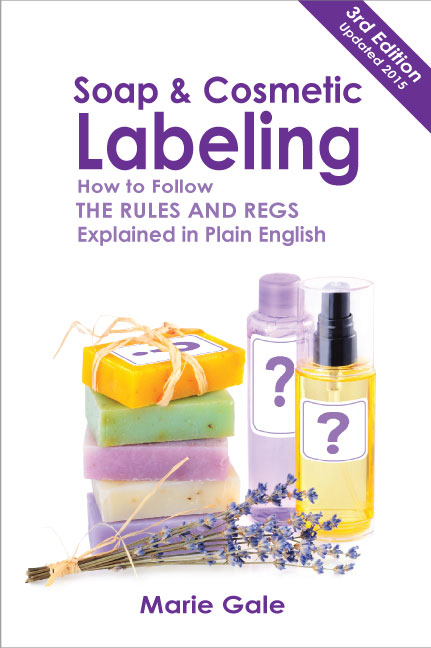Are you required to put the net contents in metric on your soap or cosmetic label? As with most regulatory questions, the answer is… it depends. The long answer (with references) is explained below. But if you want the short answer just skip to the bottom.
Overriding Law
The law that applies here is the Fair Packaging and Labeling Act. It is the law that was passed by Congress and signed by President Johnson in 1966. It requires that the net weight be placed on the label, and originally stated that it was required in inch/pound system. The law was updated in 1992 to require that product labels also require metric measurements:
Directly from the regulations:
The net quantity of contents … shall be separately and accurately stated in a uniform location upon the principal display panel of that label, using the most appropriate units of both the customary inch/pound system of measure … and … the SI metric system.
FPLA: 15 USC 1453(a)(2)
The Fair Packaging and Labeling Act is implemented through regulations by the applicable government agencies.
Soap or Cosmetic?
While the FPLA applies to all consumer products, the regulations that apply to a particular product depend on the type of product it is. The FDA has enacted regulations for food, drugs, and cosmetics; the FTC has enacted regulations for other products (including soap that is exempted from the definition of a cosmetic).
A cosmetic is defined as:
Directly from the regulations:
The term “cosmetic” means (1) articles intended to be rubbed, poured, sprinkled, or sprayed on, introduced into, or otherwise applied to the human body or any part thereof for cleansing, beautifying, promoting attractiveness, or altering the appearance, and (2) artciles intended for use as a component of any such articles; except that such term shall not include soap.
US Food and Drug Act: 21 USC 321(i)
Concerning soap, the FDA issued regulations to clarify:
Directly from the regulations:
In its definition of the term cosmetic, the Federal Food Drug, and Cosmetic Act specifically excludes soap. The term soap is nowhere defined in the act. In administering the act, the Food and Drug Administration interprets the term “soap” to apply only to articles that meet the following conditions:
(1) The bulk of the nonvolatile matter in the product consists of an alkali salt of fatty acids and the detergent properties of the article are due to the alkali-fatty acid compounds; and
(2) The product is labeled, sold and represented only as soap.
FDA Regulations: 21 CFR 701.20(a)
For more info, see also: Melt & Pour Soap: Soap or Cosmetic?

Soap
For soap, the regulations concerning the net weight and the requirements of metric measurements are issued by the Federal Trade Commission (FTC). When the FPLA was updated, the FTC regulations were also updated. They now require both inch/pound and metric (SI):
Directly from the regulations:
Units of weight or mass and measure;
(a) Statements of weight or mass shall be in terms of both avoirdupois pound and ounce and SI metric kilograms, grams, or milligrams …
(b) Statements of fluid measure shall be in terms of both the US gallon of 231 cubic inches and quart, pint, and fluid ounce subdivisions thereof and SI metric liters or milliliters …
16 CFR 500.8
Cosmetics
For cosmetics, the regulations concerning the net weight, and the requirements of metric measurements, are issued by the Food and Drug Administration (FDA). When the FPLA was updated, the FDA proposed updates to the regulations to include metric measurements, but they were never finalized.
In the proposal, submitted in 1993, the FDA said, “The proposed rules in this document reflect the agency’s current thinking regarding implementation of the FPLA as amended by the 1992 amendments.“1 So, at that time they figured the metric measurements should be included.
Unfortunately, things move at a snail’s pace (or not at all) in the FDA, and 11 years later (2004) the new regulations still hadn’t been approved. As part of a review program of “regulatory reform” the FDA withdrew a whole bunch of proposed but not finalized regulations, including the metric labeling requirements. In withdrawing the proposals, the FDA stated:
Directly from the regulations:
… withdrawal of a proposal is not intended to affect whatever utility the preamble statements may currently have as indications of the FDA’s position on the matter at the time the proposal was published, and in some cases, the preambles of these proposals may still reflect the current position of the FDA on the matter addressed.
69 Fed. Reg 68831 2004
In other words, they probably didn’t change their position about metric requirements, they just didn’t get the regulation updated.
Currently, metric measurements are not required by regulation for cosmetics, but they are still required by law (under the FPLA).
State Law
The National Institute of Standards and Technology, through the Office of Weights and Measures, publishes the NIST Handbook 130 , which includes the Uniform Packaging and Labeling Regulation (UPLR). The UPLR is a set of regulations concerning packaging and labeling that is designed to be adopted at a state level, making it easy for states to have standard labeling and packaging laws. The UPLR requires metric measurements for the net content on consumer and wholesale packages.
All US states (except for two) have adopted some form of the UPLR.
So, not only are metric measurements required at the federal level, they are also required at a state level.
The Short Version (tl;dr2)
Yes, metric measurements ARE REQUIRED on all product packages, including both soap and cosmetics.


Leave a Reply